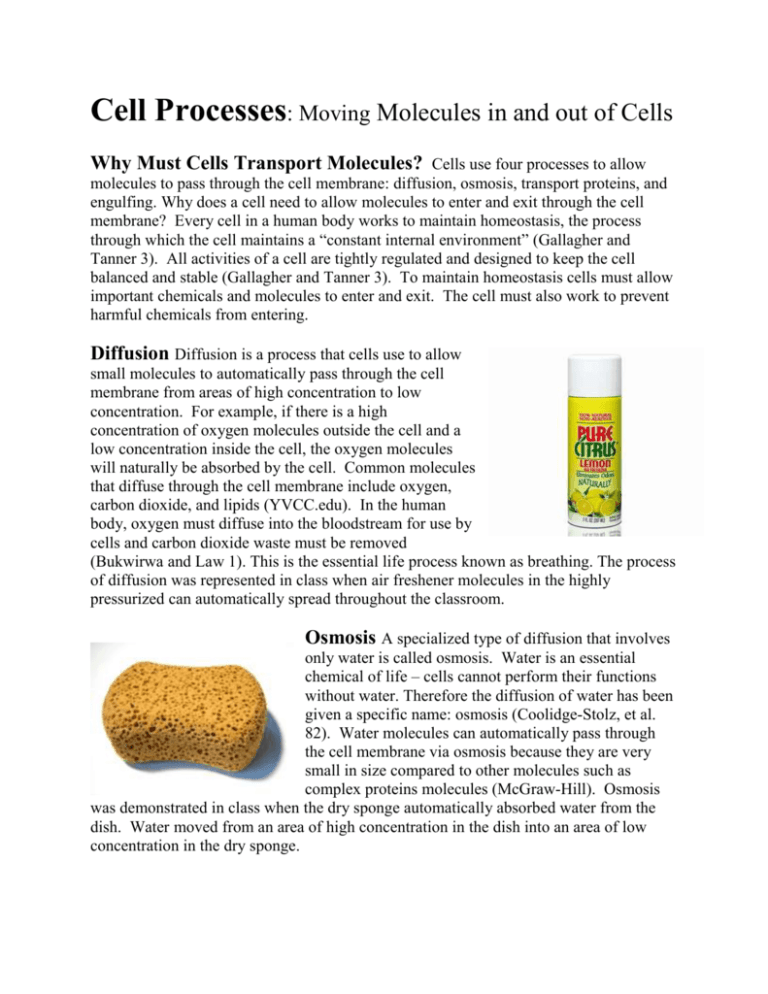Supplemental Article with Transport Comparison
advertisement

Cell Processes: Moving Molecules in and out of Cells Why Must Cells Transport Molecules? Cells use four processes to allow molecules to pass through the cell membrane: diffusion, osmosis, transport proteins, and engulfing. Why does a cell need to allow molecules to enter and exit through the cell membrane? Every cell in a human body works to maintain homeostasis, the process through which the cell maintains a “constant internal environment” (Gallagher and Tanner 3). All activities of a cell are tightly regulated and designed to keep the cell balanced and stable (Gallagher and Tanner 3). To maintain homeostasis cells must allow important chemicals and molecules to enter and exit. The cell must also work to prevent harmful chemicals from entering. Diffusion Diffusion is a process that cells use to allow small molecules to automatically pass through the cell membrane from areas of high concentration to low concentration. For example, if there is a high concentration of oxygen molecules outside the cell and a low concentration inside the cell, the oxygen molecules will naturally be absorbed by the cell. Common molecules that diffuse through the cell membrane include oxygen, carbon dioxide, and lipids (YVCC.edu). In the human body, oxygen must diffuse into the bloodstream for use by cells and carbon dioxide waste must be removed (Bukwirwa and Law 1). This is the essential life process known as breathing. The process of diffusion was represented in class when air freshener molecules in the highly pressurized can automatically spread throughout the classroom. Osmosis A specialized type of diffusion that involves only water is called osmosis. Water is an essential chemical of life – cells cannot perform their functions without water. Therefore the diffusion of water has been given a specific name: osmosis (Coolidge-Stolz, et al. 82). Water molecules can automatically pass through the cell membrane via osmosis because they are very small in size compared to other molecules such as complex proteins molecules (McGraw-Hill). Osmosis was demonstrated in class when the dry sponge automatically absorbed water from the dish. Water moved from an area of high concentration in the dish into an area of low concentration in the dry sponge. PASSIVE TRANSPORT vs. ACTIVE TRANSPORT Diffusion - The movement of small particles across the cell membrane - Particles move from areas of high concentration to low concentration - Small particles are substances like CO2 and O2 Transport proteins - Located in the cell membrane - ‘Pick-up’ particles and push them through the cell membrane - Used to push particles from an area of low concentration to an area of high concentration Osmosis - The diffusion of water across the cell membrane - Water moves from an area of high concentration to low concentration Engulfing - Used to push large particles through the cell membrane - The cell membrane surrounds a particle and pinches off and brings it into the cell - Lysosomes surround wastes and join with the cell membrane to push them out of the cell - The cell does not use energy for diffusion or osmosis Particles move from an area of higher concentration to lower concentration EX: Air freshener leaving the can (high concentration) and spreading throughout the room (low concentration) EX: A dry sponge (low concentration) soaking up water from a dish (high concentration) High concentration low concentration (glass of water) (dry sponge) - The cell must use energy for these processes Involves the movement of large particles through the cell membrane (engulfing) Involves the movement of particles from an area of low concentration to high concentration (transport proteins) EX: Pushing air freshener back into the can EX: Wringing water out of a sponge into a dish of water Engulfing (surrounding) Transport proteins (pick-up and move particles)









